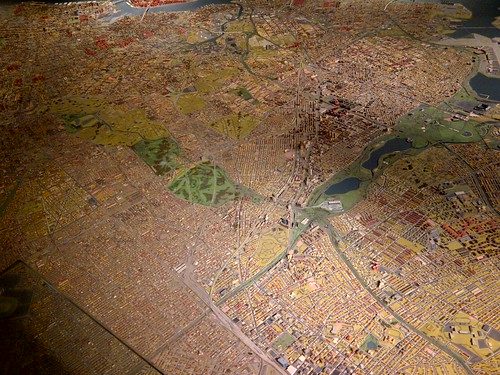This week I had a lot of shows to see but unfortunately my body had other plans. I missed Frank Turner on Sunday night, Alabama Shakes on Thursday night, and the first night of the New Yorker Festival with music and interviews with the Punch Brothers. At least I got myself out of bed for Program 3 of Fall for Dance. It was well worth it and almost (almost) made up for missing so much else this week.
rtb and I met outside the theater early so we could try the dinner special. For Program 1 it was pot roast and for program 3 it was seafood paella. The plates are small but so is the price. Unfortunately they don’t set up the Grand Tier for real eating so you’re either standing at a table or sitting on the stairs.
This time I got orchestra seats. They were last row audience left and the mezzanine made it feel cramped. I wasn’t so sure if I was going to enjoy the orchestra, but except for missing the symmetry and some entrances from stage right, they were actually very good seats.
First was Ballet West from Salt Lake City performing the Grand Pas from Paquita. This is an opportunity for each ballerina to shine. Since this was classical ballet I would have preferred Ludwig Minkus’ music to be live. I find with classical ballet that recorded music takes me out of the moment – I need to hear real instruments and I think there’s a back-and-forth between the conductor and the dancers that adds to the excitement and the you-are-there quality. The costumes (David Heuvel) were magnificent. White short tulle skirts were scattered with gold and the bodices of the three types of dancers were each different but all flecked with some kind of gold. The one male dancer wore skin-colored tights that left nothing to the imagination. Each of the dancers got a moment to shine with Sayaka Ohtaki (soloist) shining a bit more than the others. The other dancers were principal artist Christiana Bennett and demi-soloist Rex Tilton in the lead roles, demi-soloists Emily Adams and Beckanne Sisk, and corps artist Lindsay Duerfeldt dancing solos and corps de ballet Katlyn Addison, Katie Critchlow (demi-soloist), Jenna Rae Herrera, Whitney Huell, Jordan Richardson, Jamie Lynn Schultz, Jacqueline Straughan (soloist), and Elizabeth Weldon. Artistic director is Adam Skulte and choreography is by Elena Kunikova after Marius Petipa.
Next was Tu Dance performing the New York premiere High Heel Blues, to the song by Tuck and Patti, sung a cappella by Patti Cathcart. Artistic directors Uri Sands and Toni Pierce-Sands were formerly with Alvin Ailey and if I hadn’t read that I would still know it. There was no mistaking the long skirt and those high steps choreographed by Sands as coming from anywhere else. Sands is a shoe salesman and Yusha Marie Sorzano is a woman conflicted – she loves those high heel shoes but they cause her pain. But they look so good. But they cost too much. But they look good. It’s a short humorous piece and Sands and Sorzano found a perfect balance.
After intermission was Nan Jombang, a West Sumatra drumming, dance, and martial arts company, performing the US premiere of Tarian Malam (Night Dances). All the dancers were costumed in long red skirts. It begins with woman alone – calling, wailing out into the night sky. To my American ears the wailing sounded similar to Native American calls. A man enters and there is a silent foreplay – the two rolling around each other both on and off the drum. The other dancers enter playing the drums and then the company bangs out rhythms – by clapping, by drumming, by slapping their skirts. They continue banging and yelling and dancing at the night sky. Dancers are choreographer Ery Mefri, Angga Mefri, Rio Mefri, Geby Mefri, Intan Mefri, Ririn Mefri, Tonny Ryadi, and Rahmat Dani.
The evening ended on a higher than high note with the Moiseyev Dance Company (artistic director Elena Shcherbakova) dancing the choreography of Igor Moiseyev to music by P. Rybakov, E. Avksentiev, S. Galperin, an D. Fyodov. The dances celebrate the different regions of Russia. In Kalmyk Dance, Ramil Mek hdiev, Yury Chernyshkov, and Roman Ivashchenko imitate the animals and birds that surround the nomads. There was a lot of shimmying and a lot of laughter from the audience. In Tatarotchka Olga Volina (looking like a stewardess for a Aeroflot), Oleg Chernasov, and Evegny Masalkov take the elements of the Tartar national dance and whirl around the stage in joyous leaps. The Dance of Bessarabia Gypsies looked like you’d expect. Women move slowly and sexily while the men watch and then can’t resist joining in and dancing with them. Dancers were Anastasia Sorokina, Anna Glukhova, Maria Nikolaeva, Kirill Kochubey, Sergey Prokhorov, Alexander Tikhonov, Ramil Mekhdiev, Daniil Kasatkin, and Roman Ivashchenko. The colors and costumes on the women and the men were beautiful. Finishing was a Suite of Moldavian Dances, where the entire company lept and crouched, and did rounds, and solos all while using their bodies as percussion. Soloists were Olga Volina, Veronika Denisova, and Yury Chernyshkov.
Another wonderful night of dance.
By Carene Lydia Lopez


